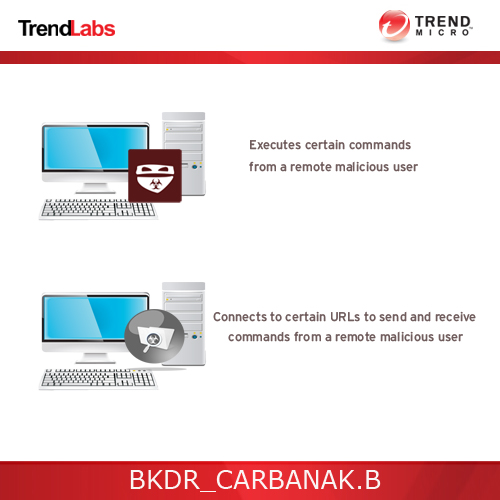BKDR_CARBANAK.B
W32/Kryptik.CKUG!tr (Fortinet); Trojan.Carberp.B (Symantec); PWS:Win32/Sekur (Microsoft)
Windows


Threat Type: Backdoor
Destructiveness: No
Encrypted:
In the wild: Yes
OVERVIEW
Dropped by other malware
This is the latest CARBANAK variant reportedly related to the compromised Microsoft Windows client. CARBANAK is a malware family that hits banks and financial organizations.
To get a one-glance comprehensive view of the behavior of this Backdoor, refer to the Threat Diagram shown below.

This backdoor may be dropped by other malware.
It executes commands from a remote malicious user, effectively compromising the affected system. It connects to a website to send and receive information.
It deletes itself after execution.
TECHNICAL DETAILS
186,880 bytes
EXE
No
19 Mar 2015
Connects to URLs/IPs, Compromises system security
Arrival Details
This backdoor may be dropped by the following malware:
Installation
This backdoor drops the following copies of itself into the affected system:
- %System%\Com\svchost.exe
(Note: %System% is the Windows system folder, where it usually is C:\Windows\System32 on all Windows operating system versions.)
It creates the following folders:
- %All Users Profile%\Application Data\Mozilla
(Note: %All Users Profile% is the All Users folder, where it usually is C:\Documents and Settings\All Users on Windows 2000, Windows Server 2003, and Windows XP (32- and 64-bit); C:\ProgramData on Windows Vista (32- and 64-bit), Windows 7 (32- and 64-bit), Windows 8 (32- and 64-bit), Windows 8.1 (32- and 64-bit), Windows Server 2008, and Windows Server 2012.)
It injects codes into the following process(es):
- svchost.exe
Autostart Technique
This backdoor registers itself as a system service to ensure its automatic execution at every system startup by adding the following registry entries:
HKEY_LOCAL_MACHINE\SYSTEM\ControlSet001\
Services\{random service name}Sys
ImagePath = "%System%\Com\svchost.exe"
It registers as a system service to ensure its automatic execution at every system startup by adding the following registry keys:
HKEY_LOCAL_MACHINE\SYSTEM\ControlSet001\
Services\{random service name}Sys
Backdoor Routine
This backdoor executes the following commands from a remote malicious user:
- Check state of malware
- Captures screenshots
- Download configuration file
- Dowload and run another executable
- Download third party remote desktop protocol software that will be used for remote access
- Checks for updates
- Restarting the machine
It connects to the following websites to send and receive information:
- {BLOCKED}1.{BLOCKED}1.17.125
Other Details
This backdoor drops the following file(s)/component(s):
- %All Users Profile%\Application Data\Mozilla\AgpNWwQJbVpfCANZVw.bin - contains backdoor command
(Note: %All Users Profile% is the All Users folder, where it usually is C:\Documents and Settings\All Users on Windows 2000, Windows Server 2003, and Windows XP (32- and 64-bit); C:\ProgramData on Windows Vista (32- and 64-bit), Windows 7 (32- and 64-bit), Windows 8 (32- and 64-bit), Windows 8.1 (32- and 64-bit), Windows Server 2008, and Windows Server 2012.)
It deletes itself after execution.
SOLUTION
9.700
Step 1
Before doing any scans, Windows XP, Windows Vista, and Windows 7 users must disable System Restore to allow full scanning of their computers.
Step 2
Note that not all files, folders, and registry keys and entries are installed on your computer during this malware's/spyware's/grayware's execution. This may be due to incomplete installation or other operating system conditions. If you do not find the same files/folders/registry information, please proceed to the next step.
Step 3
Remove the malware/grayware file that dropped/downloaded BKDR_CARBANAK.B. (Note: Please skip this step if the threat(s) listed below have already been removed.)
Step 4
Restart in Safe Mode
Step 5
Delete this registry key
Important: Editing the Windows Registry incorrectly can lead to irreversible system malfunction. Please do this step only if you know how or you can ask assistance from your system administrator. Else, check this Microsoft article first before modifying your computer's registry. Before you could do this, you must restart in Safe Mode. For instructions on how to do this, you may refer to this page If the preceding step requires you to restart in safe mode, you may proceed to edit the system registry.
- In HKEY_LOCAL_MACHINE\SYSTEM\ControlSet001\Services
- {random service name}Sys
- {random service name}Sys
Step 6
Search and delete this folder
- %All Users Profile%\Application Data\Mozilla
Step 7
Search and delete these files
- %All Users Profile%\Application Data\Mozilla\AgpNWwQJbVpfCANZVw.bin
- %System%\Com\svchost.exe
Step 8
Restart in normal mode and scan your computer with your Trend Micro product for files detected as BKDR_CARBANAK.B. If the detected files have already been cleaned, deleted, or quarantined by your Trend Micro product, no further step is required. You may opt to simply delete the quarantined files. Please check this Knowledge Base page for more information.
Did this description help? Tell us how we did.

